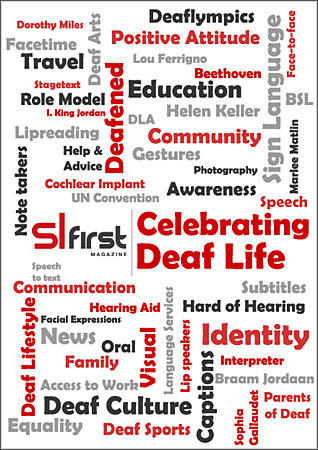Language & Communication15th February 2016
Whole Life Benefits From Access to Sign Language - Birth To Three
New research not only supports the benefits of signing in acquiring language skills, but finds it boosts brain power

I am often asked, “Why do you support the use of sign language with Deaf babies and toddlers so much, even for those who use hearing aids or have Cochlear Implants fitted?” My response, “Because failure to do so is likely to hold back that child, not just in those early years, but potentially for the rest of it’s life.” You see, you can argue with science, but when the same or similar findings come up time after time, I don’t understand why people do.
 The American Association for the Advancement of Science (AAAS) Annual Meeting in Washington ends today, but it does not do so without once again introducing new research that proves the benefit of early exposure to sign language. Not opinions of mums, dads, teachers or audiologists, scientific research!
The American Association for the Advancement of Science (AAAS) Annual Meeting in Washington ends today, but it does not do so without once again introducing new research that proves the benefit of early exposure to sign language. Not opinions of mums, dads, teachers or audiologists, scientific research!
The AAAS annual meeting is interdisciplinary and inclusive. Each year, thousands of leading scientists, engineers, educators, policymakers, and journalists gather together to discuss recent developments in science and technology. The topics presented and discussed are numerous, requiring a meeting that started on the 11th February and finishes today, the 15th.
One of the presenters taking to the stage on the second day of the meeting was clinical neuropsychologist, Peter Hauser. Peter is Deaf, which explains his area of study, but his recent findings not only support much of the previous research about language development in deaf children, but it goes even further. Put simply, his findings say that exposure to signing before the age of 3 can boost the brainpower of deaf children.
 Delivering his address in sign language, Peter Hauser re-iterated that language is a unique human capability and yet its impact on cognitive development is largely unknown. Commenting on some of the previous research projects in this area, he explained that researchers in the past had often relied on cases where children had experienced language deprivation because of their situation. Looking at more recent studies, he acknowledged that researchers had begun to look at children who have access to sign language and their development set against those who did not.
Delivering his address in sign language, Peter Hauser re-iterated that language is a unique human capability and yet its impact on cognitive development is largely unknown. Commenting on some of the previous research projects in this area, he explained that researchers in the past had often relied on cases where children had experienced language deprivation because of their situation. Looking at more recent studies, he acknowledged that researchers had begun to look at children who have access to sign language and their development set against those who did not.
“Most deaf children are born to hearing families, and most hearing parents do not sign with their newborn deaf children,” Peter explained. “The deaf children, as a consequence, have very limited exposure to sign language.”
 As Peter outlined, this means that many of these deaf children are raised in non-traditional language environments, often including the need to improvise to communicate and leading to significant language delay. When my own mother was trying to teach me about road safety and the importance of staying on school grounds during the day, what she did to develop a model of the roads outside school was quite brilliant and creative, but it meant I learned that message visually not through new language.
As Peter outlined, this means that many of these deaf children are raised in non-traditional language environments, often including the need to improvise to communicate and leading to significant language delay. When my own mother was trying to teach me about road safety and the importance of staying on school grounds during the day, what she did to develop a model of the roads outside school was quite brilliant and creative, but it meant I learned that message visually not through new language.
Talking about the 5% of deaf children, born into Deaf families, Peter re-iterated what many before have said. Deaf children raised by deaf parents who are able to make language accessible to their children at home, experience typical language development and achieve language developmental milestones similar to hearing children.
The technical research bit - His current study investigated how language deprivation experienced by deaf children of hearing parents has an impact on higher order cognitive abilities compared to those raised by deaf parents (meaning high-level mental effort that involves controlling attention, impulses and emotions). The study focused on the executive functions that are responsible for optimal learning and social behavior and involved 115 deaf children.
 The ‘Colour Trails Test’ was undertaken by deaf children and adults. The test required them to connect numbered circles sequentially, while alternating the circles’ colours (line from a pink circle with the number 1 to a yellow circle with the number 2 while ignoring the pink circle with the number 2 and so on). It’s not as simple as it sounds because of the constant natural urge to join disks of the same colour. The task requires cognitive flexibility to shift attention while ignoring the distractions that are thrown at you. The time it took participants to complete the task was recorded.
The ‘Colour Trails Test’ was undertaken by deaf children and adults. The test required them to connect numbered circles sequentially, while alternating the circles’ colours (line from a pink circle with the number 1 to a yellow circle with the number 2 while ignoring the pink circle with the number 2 and so on). It’s not as simple as it sounds because of the constant natural urge to join disks of the same colour. The task requires cognitive flexibility to shift attention while ignoring the distractions that are thrown at you. The time it took participants to complete the task was recorded.
Compared with the children who had been exposed to signing from birth, children who didn’t learn to sign until around the age of 3 or later, took about 17 seconds longer to complete the task. What is more, and will be of significant interest to parents of deaf children, the late signers don’t seem to ever catch up. In similar tests undertaken with 40 adults, native signers beat the times of late signers by 23 seconds, allowing Peter Hauser to conclude that denial of sign language at an early age will have lasting effects.
 Re-affirming what I and many people in the Deaf community have believed for a long time, the results once again demonstrate why it is beneficial for every deaf child to have access to sign language from the earliest possible moment. Access to sign language early in life is undoubtedly the best solution to achieve maximum language and cognitive ability for education and later in life. Parents of deaf children should be advised about the benefits of sign language, not dissuaded, which is often the case, and parents should be supported to learn sign language quickly and effectively so that they can play their part in their child’s language acquisition.
Re-affirming what I and many people in the Deaf community have believed for a long time, the results once again demonstrate why it is beneficial for every deaf child to have access to sign language from the earliest possible moment. Access to sign language early in life is undoubtedly the best solution to achieve maximum language and cognitive ability for education and later in life. Parents of deaf children should be advised about the benefits of sign language, not dissuaded, which is often the case, and parents should be supported to learn sign language quickly and effectively so that they can play their part in their child’s language acquisition.
Article by Sarah Lawrence, Editor
posted in Community / Language & Communication
15th February 2016





